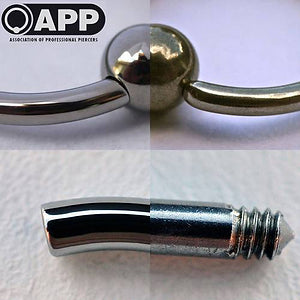
What I hear very often from people is "I am pierced with surgical steel, since it is used in surgery it must be top quality." ERROR!
Surgical Steel.
Surgical steel is an umbrella term that is used for any metal that is used, among other things, in the medical sector. But there is no standard or exact definition of this. This term is applied to any stainless type of metal. Think of tap installations in cafes, tables, chairs, kitchen utensils, door handles, car tools...

Since there is no standard for this, manufacturers can use everything for the alloy of this metal, which is why we call this 'mystery metal' in the piercing industry. The cheapest and most commonly used alloy for surgical steel is nickel. A large percentage of people in our culture have a certain reaction or allergy to this and this can make for a very unfortunate piercing.
The finish of surgical steel piercings is also very low, so they are not polished and often contain scratches that then bring bacteria and irritation into a healing piercing.
These piercings are also very cheap to purchase and piercers can make a very nice profit margin in this way.
Implant grade titanium (ASTM F-136 ELI)
At LPR piercing Knokke we only use implant grade titanium and solid gold, for both starting and healing piercings.
What does this mean now?
ASTM = American Standard Test Method
F = Metals that may be used in medical applications
ELI = Extra Low Interstitial, a higher grade metal that may be used for long-term implants. Such as a new knee or hip implant.

Let's take a closer look at ASTM. Manufacturers who work with metal according to ASTM must comply with certain rules, and must make a 'Mill Certificate' of everything that is checked by ASTM itself. This is a document that shows the chemical composition of the entire product and makes it very clear what is in the alloy of that metal down to the smallest details. Often European suppliers are going to counterfeit these, but these manufacturers are known to ASTM and their names are known.
The European Union made a regulation in 2009 that a certain amount of nickel is acceptable, also in jewellery.
“But if we know nickel is bad, why does Europe allow it?” Same reason as why cigarettes are still sold.
There is also such a thing as ASTM F-138, which is implant grade steel. Piercings that also go through this test process and are sure that, among other things, no nickel gets into the process.
Since ASTM jewelry is mainly produced in America, where these are checked and tested step by step and we have to pay import taxes and customs costs, these jewelry are a bit more expensive at the end of the bill, it also takes a bit longer to obtain this through transport. .
That is why our prices are slightly more expensive and many piercers in Europe do not yet work with this quality.
More and more manufacturers in Europe are starting to pay attention to this and are doing their best to strive for this but this will take some time.
Many American suppliers meanwhile have distributors in Europe and the UK, so we can get these jewels faster and faster, but the price remains the same.
For me the safety of the customer and a good healing is the most important and therefore our prices are sometimes a bit more expensive than in other shops.

Surgical Steel.
Surgical steel is an umbrella term that is used for any metal that is used, among other things, in the medical sector. But there is no standard or exact definition of this. This term is applied to any stainless type of metal. Think of tap installations in cafes, tables, chairs, kitchen utensils, door handles, car tools...

Since there is no standard for this, manufacturers can use everything for the alloy of this metal, which is why we call this 'mystery metal' in the piercing industry. The cheapest and most commonly used alloy for surgical steel is nickel. A large percentage of people in our culture have a certain reaction or allergy to this and this can make for a very unfortunate piercing.
The finish of surgical steel piercings is also very low, so they are not polished and often contain scratches that then bring bacteria and irritation into a healing piercing.
These piercings are also very cheap to purchase and piercers can make a very nice profit margin in this way.
Implant grade titanium (ASTM F-136 ELI)
At LPR piercing Knokke we only use implant grade titanium and solid gold, for both starting and healing piercings.
What does this mean now?
ASTM = American Standard Test Method
F = Metals that may be used in medical applications
ELI = Extra Low Interstitial, a higher grade metal that may be used for long-term implants. Such as a new knee or hip implant.

Photo credit "Amato Fine Jewelry and Body Piercing" On the left you see implant grade titanium, on the right surgical steel. This is also internally screwed and externally screwed, I will write about that in another blog.
Let's take a closer look at ASTM. Manufacturers who work with metal according to ASTM must comply with certain rules, and must make a 'Mill Certificate' of everything that is checked by ASTM itself. This is a document that shows the chemical composition of the entire product and makes it very clear what is in the alloy of that metal down to the smallest details. Often European suppliers are going to counterfeit these, but these manufacturers are known to ASTM and their names are known.
The European Union made a regulation in 2009 that a certain amount of nickel is acceptable, also in jewellery.
“But if we know nickel is bad, why does Europe allow it?” Same reason as why cigarettes are still sold.
There is also such a thing as ASTM F-138, which is implant grade steel. Piercings that also go through this test process and are sure that, among other things, no nickel gets into the process.
Since ASTM jewelry is mainly produced in America, where these are checked and tested step by step and we have to pay import taxes and customs costs, these jewelry are a bit more expensive at the end of the bill, it also takes a bit longer to obtain this through transport. .
That is why our prices are slightly more expensive and many piercers in Europe do not yet work with this quality.
More and more manufacturers in Europe are starting to pay attention to this and are doing their best to strive for this but this will take some time.
Many American suppliers meanwhile have distributors in Europe and the UK, so we can get these jewels faster and faster, but the price remains the same.
For me the safety of the customer and a good healing is the most important and therefore our prices are sometimes a bit more expensive than in other shops.

